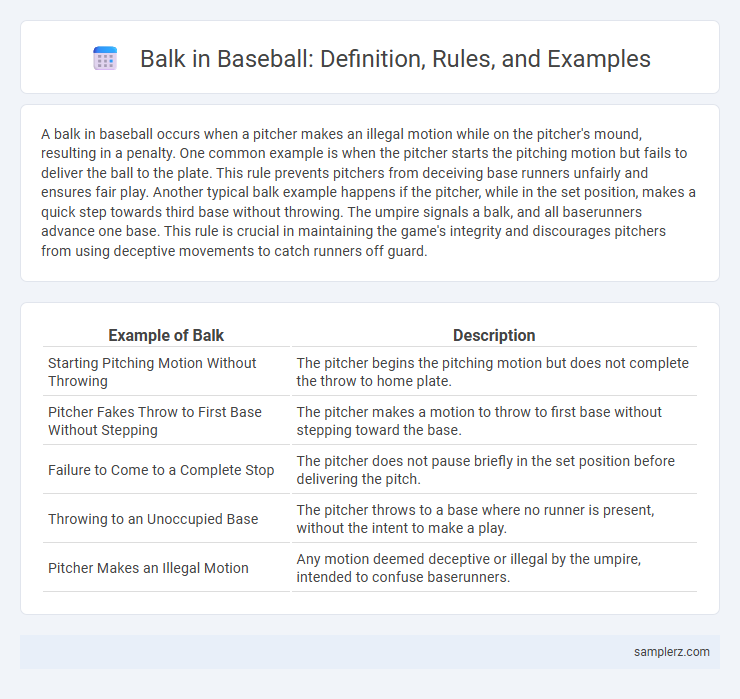A balk in baseball occurs when a pitcher makes an illegal motion while on the pitcher's mound, resulting in a penalty. One common example is when the pitcher starts the pitching motion but fails to deliver the ball to the plate. This rule prevents pitchers from deceiving base runners unfairly and ensures fair play. Another typical balk example happens if the pitcher, while in the set position, makes a quick step towards third base without throwing. The umpire signals a balk, and all baserunners advance one base. This rule is crucial in maintaining the game's integrity and discourages pitchers from using deceptive movements to catch runners off guard.
Table of Comparison
| Example of Balk | Description |
|---|---|
| Starting Pitching Motion Without Throwing | The pitcher begins the pitching motion but does not complete the throw to home plate. |
| Pitcher Fakes Throw to First Base Without Stepping | The pitcher makes a motion to throw to first base without stepping toward the base. |
| Failure to Come to a Complete Stop | The pitcher does not pause briefly in the set position before delivering the pitch. |
| Throwing to an Unoccupied Base | The pitcher throws to a base where no runner is present, without the intent to make a play. |
| Pitcher Makes an Illegal Motion | Any motion deemed deceptive or illegal by the umpire, intended to confuse baserunners. |
Understanding the Balk: Definition and Rules
A balk in baseball occurs when a pitcher makes an illegal motion while on the mound, deceiving the baserunners and resulting in a penalty. Common examples include starting to pitch but stopping mid-delivery, failing to step toward a base when throwing, or dropping the ball while in contact with the pitching rubber. According to MLB rules, any balk grants all baserunners one base, emphasizing strict enforcement to maintain fair play.
Classic Example: Pitcher Stops Mid-Delivery
A classic example of a balk in baseball occurs when the pitcher abruptly stops mid-delivery, deceiving the base runners. This illegal move results in the umpire awarding all runners one base. The balk rule maintains fair play by preventing pitchers from unfairly freezing runners on base.
Balk for Faking a Throw to First Base
A balk occurs when a pitcher fakes a throw to first base without completing the pitch, deceiving the runner and violating baseball rules. This illegal motion is intended to confuse base runners but results in all runners advancing one base. The umpire enforces the balk penalty by calling the play dead and awarding bases accordingly, emphasizing fair play in baseball.
Quick Pitch: An Illegally Fast Delivery
A quick pitch occurs when the pitcher delivers the ball to the batter before the batter is ready, violating baseball rules designed to ensure fair play. This illegal fast delivery disrupts the batter's timing and is considered a balk when the pitcher has runners on base, resulting in advances for those runners. Umpires enforce this rule to maintain game integrity and prevent pitchers from gaining an unfair advantage.
Flinching or Illegal Movement on the Mound
A balk in baseball occurs when the pitcher makes an illegal movement on the mound, such as flinching or failing to properly step toward a base before throwing. This deceptive action is intended to mislead baserunners but results in the umpire calling a balk, allowing runners to advance. Understanding the specific rules governing balks is crucial for pitchers to avoid penalties during critical game situations.
Failure to Come Set with Runners On Base
A common example of a balk in baseball occurs when the pitcher fails to come set with runners on base before delivering the pitch. This rule ensures the pitcher maintains a consistent and legal pitching motion to prevent deceptive moves that could unfairly catch runners off guard. The balk results in all runners advancing one base, significantly impacting the game's momentum and strategy.
Illegal Pickoff Attempt to an Unoccupied Base
An illegal pickoff attempt to an unoccupied base in baseball occurs when a pitcher throws or feints to a base without a runner, violating balk rules. This illegal move results in a balk call, allowing all runners to advance one base. Umpires enforce this to prevent pitchers from deceiving baserunners unfairly during pickoff attempts.
Stepping Off the Rubber Incorrectly
Stepping off the rubber incorrectly during a pitch is a common example of a balk in baseball, resulting in a penalty that advances all base runners by one base. This occurs when the pitcher removes one foot from the pitching rubber without properly disengaging, violating MLB rules designed to prevent deceptive actions. Umpires closely monitor pitchers to ensure rules compliance, as balks can significantly affect game strategy by altering runner positions.
Dropping the Ball While on the Mound
Dropping the ball while on the mound constitutes a balk if the pitcher is engaged in the pitching motion and deceives the baserunners. MLB rules specify that if the pitcher loses control of the ball or intentionally drops it without making a proper pitch, all runners advance one base. This balk enforcement aims to prevent pitchers from gaining an unfair advantage through deceptive actions during pitching.
Simultaneous Motions Toward Home and a Base
A balk in baseball occurs when a pitcher makes simultaneous motions toward home plate and a base without completing a pitch, misleading the runner. This illegal action results in all runners advancing one base, according to MLB rules designed to prevent deception. Balks often happen during pickoff attempts when the pitcher's movements are not clearly defined or combined improperly.

example of balk in baseball Infographic
 samplerz.com
samplerz.com